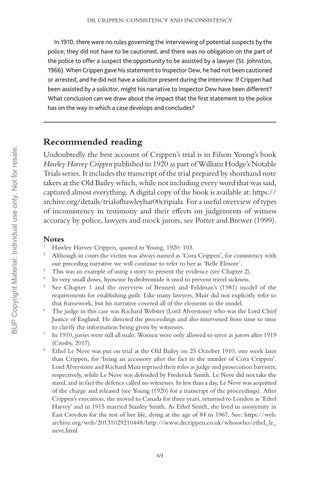DR CRIPPEN: CONSISTENCY AND INCONSISTENCY
BUP Copyright Material: Individual use only. Not for resale.
In 1910, there were no rules governing the interviewing of potential suspects by the police; they did not have to be cautioned, and there was no obligation on the part of the police to offer a suspect the opportunity to be assisted by a lawyer (St. Johnston, 1966). When Crippen gave his statement to Inspector Dew, he had not been cautioned or arrested, and he did not have a solicitor present during the interview. If Crippen had been assisted by a solicitor, might his narrative to Inspector Dew have been different? What conclusion can we draw about the impact that the first statement to the police has on the way in which a case develops and concludes?
Recommended reading Undoubtedly the best account of Crippen’s trial is in Filson Young’s book Hawley Harvey Crippen published in 1920 as part of William Hodge’s Notable Trials series. It includes the transcript of the trial prepared by shorthand note takers at the Old Bailey which, while not including every word that was said, captured almost everything. A digital copy of the book is available at: https:// archive.org/details/trialofhawleyhar00cripiala. For a useful overview of types of inconsistency in testimony and their effects on judgements of witness accuracy by police, lawyers and mock jurors, see Potter and Brewer (1999). Notes 1 2
3 4 5
6
7
8
Hawley Harvey Crippen, quoted in Young, 1920: 103. Although in court the victim was always named as ‘Cora Crippen’, for consistency with our preceding narrative we will continue to refer to her as ‘Belle Elmore’. This was an example of using a story to present the evidence (see Chapter 2). In very small doses, hyoscine hydrobromide is used to prevent travel sickness. See Chapter 1 and the overview of Bennett and Feldman’s (1981) model of the requirements for establishing guilt. Like many lawyers, Muir did not explicitly refer to that framework, but his narrative covered all of the elements in the model. The judge in this case was Richard Webster (Lord Alverstone) who was the Lord Chief Justice of England. He directed the proceedings and also intervened from time to time to clarify the information being given by witnesses. In 1910, juries were still all male. Women were only allowed to serve as jurors after 1919 (Crosby, 2017). Ethel Le Neve was put on trial at the Old Bailey on 25 October 1910, one week later than Crippen, for ‘being an accessory after the fact in the murder of Cora Crippen’. Lord Alverstone and Richard Muir reprised their roles as judge and prosecution barrister, respectively, while Le Neve was defended by Frederick Smith. Le Neve did not take the stand, and in fact the defence called no witnesses. In less than a day, Le Neve was acquitted of the charge and released (see Young (1920) for a transcript of the proceedings). After Crippen’s execution, she moved to Canada for three years, returned to London as ‘Ethel Harvey’ and in 1915 married Stanley Smith. As Ethel Smith, she lived in anonymity in East Croydon for the rest of her life, dying at the age of 84 in 1967. See: https://web. archive.org/web/20131029210448/http://www.drcrippen.co.uk/whoswho/ethel_le_ neve.html
69

